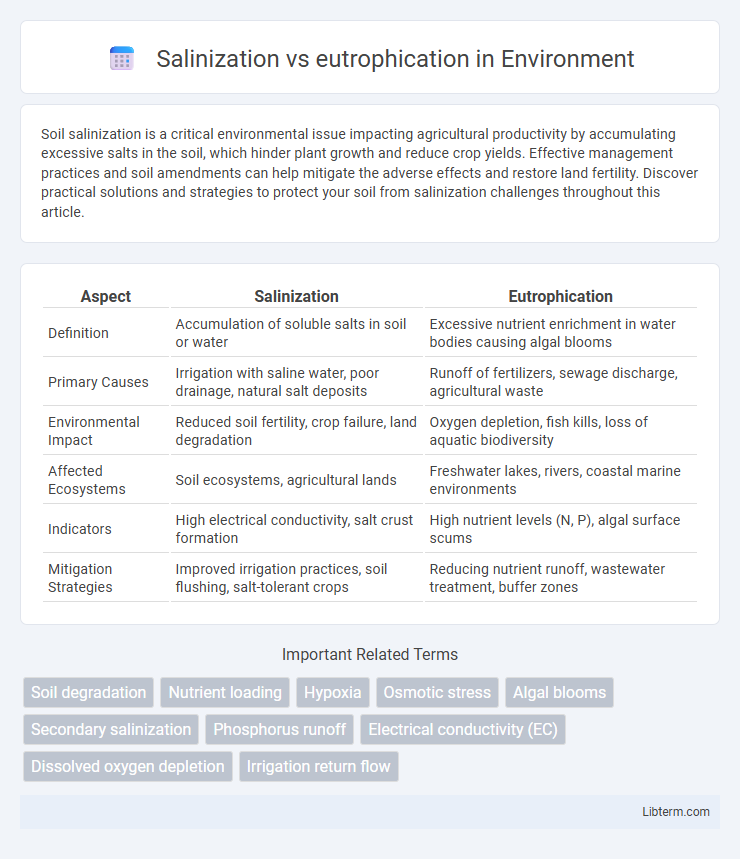Soil salinization is a critical environmental issue impacting agricultural productivity by accumulating excessive salts in the soil, which hinder plant growth and reduce crop yields. Effective management practices and soil amendments can help mitigate the adverse effects and restore land fertility. Discover practical solutions and strategies to protect your soil from salinization challenges throughout this article.
Table of Comparison
| Aspect | Salinization | Eutrophication |
|---|---|---|
| Definition | Accumulation of soluble salts in soil or water | Excessive nutrient enrichment in water bodies causing algal blooms |
| Primary Causes | Irrigation with saline water, poor drainage, natural salt deposits | Runoff of fertilizers, sewage discharge, agricultural waste |
| Environmental Impact | Reduced soil fertility, crop failure, land degradation | Oxygen depletion, fish kills, loss of aquatic biodiversity |
| Affected Ecosystems | Soil ecosystems, agricultural lands | Freshwater lakes, rivers, coastal marine environments |
| Indicators | High electrical conductivity, salt crust formation | High nutrient levels (N, P), algal surface scums |
| Mitigation Strategies | Improved irrigation practices, soil flushing, salt-tolerant crops | Reducing nutrient runoff, wastewater treatment, buffer zones |
Introduction to Salinization and Eutrophication
Salinization is the process of increasing salt concentration in soil or water, which negatively impacts agricultural productivity and ecosystem health. Eutrophication occurs when excess nutrients, particularly nitrogen and phosphorus, enter aquatic ecosystems, leading to overgrowth of algae and oxygen depletion. Both processes disrupt environmental balance, but salinization primarily affects terrestrial systems, while eutrophication primarily impacts aquatic habitats.
Defining Salinization: Causes and Processes
Salinization refers to the accumulation of soluble salts in soil or water, primarily caused by natural processes like mineral weathering and human activities such as excessive irrigation and poor drainage. This process leads to reduced soil fertility and impaired plant growth due to increased salt concentration, disrupting osmotic balance and nutrient uptake. Understanding salinization involves examining water movement, evaporation rates, and salt sources, making it crucial to manage agricultural practices and protect freshwater ecosystems.
Understanding Eutrophication: Key Drivers
Eutrophication is a process driven primarily by excess nutrients, especially nitrogen and phosphorus, entering aquatic ecosystems from agricultural runoff, wastewater discharge, and industrial effluents. These nutrients stimulate rapid algal blooms, which deplete oxygen levels when they decay, causing hypoxia and harming aquatic life. Understanding nutrient sources and their cycling is crucial for managing eutrophication and preventing ecological degradation in freshwater and marine environments.
Sources of Salinity in Water Bodies
Salinity in water bodies primarily originates from natural processes such as the weathering of rocks, evaporation in arid regions, and the intrusion of seawater into freshwater systems. Human activities like irrigation with saline water, excessive groundwater extraction, and the application of road salts contribute significantly to increasing salinity levels. Elevated salinity disrupts aquatic ecosystems by altering water chemistry and reducing biodiversity, posing distinct challenges compared to eutrophication, which is driven by excess nutrients like nitrogen and phosphorus.
Nutrient Pollution and Eutrophication
Nutrient pollution, primarily from excess nitrogen and phosphorus, drives eutrophication by stimulating the overgrowth of algae in aquatic ecosystems, leading to oxygen depletion and harmful algal blooms. Salinization, on the other hand, involves the accumulation of soluble salts in soil or water, which affects plant growth and soil health but does not directly contribute to nutrient-driven eutrophication. Eutrophication's ecological impacts stem from nutrient imbalances causing hypoxia, while salinization primarily challenges agricultural productivity through increased soil salinity.
Environmental Impacts: Salinization vs Eutrophication
Salinization leads to soil degradation by increasing salt concentration, which disrupts plant growth and reduces agricultural productivity, causing long-term damage to ecosystems. Eutrophication results from nutrient overloading, particularly nitrogen and phosphorus, promoting excessive algal blooms that deplete oxygen in water bodies, leading to aquatic dead zones and biodiversity loss. Both processes dramatically alter natural habitats, but salinization primarily affects terrestrial environments, whereas eutrophication impacts freshwater and marine ecosystems.
Effects on Aquatic Life and Biodiversity
Salinization increases water salinity, disrupting osmoregulation in freshwater aquatic species, leading to decreased biodiversity and altered ecosystem dynamics. Eutrophication causes excessive nutrient enrichment, promoting algal blooms that reduce oxygen levels and create hypoxic conditions, severely impacting fish populations and aquatic invertebrates. Both processes contribute to habitat degradation, but salinization primarily affects species adapted to freshwater, while eutrophication causes nutrient imbalances that trigger cascading effects throughout aquatic food webs.
Human Activities Accelerating Salinization and Eutrophication
Human activities such as excessive irrigation, deforestation, and improper land management significantly accelerate salinization by increasing soil salt accumulation and reducing natural drainage. Industrial discharge, agricultural runoff rich in nitrogen and phosphorus fertilizers, and untreated sewage amplify eutrophication, causing harmful algal blooms and oxygen depletion in aquatic ecosystems. Both processes deteriorate water quality, threaten biodiversity, and impair agricultural productivity, highlighting the urgent need for sustainable environmental practices.
Management and Mitigation Strategies
Effective management of salinization involves improved irrigation techniques such as drip irrigation and the use of salt-tolerant crop varieties to reduce soil salt accumulation. Eutrophication mitigation relies on controlling nutrient inputs by implementing buffer strips, optimizing fertilizer application, and promoting wetland restoration to enhance nutrient uptake and reduce runoff. Integrating these strategies with continuous monitoring and adaptive land management ensures sustainable soil and water quality in agricultural and aquatic ecosystems.
Comparing Salinization and Eutrophication: Key Differences
Salinization is the process of increasing salt concentration in soil or water, primarily caused by irrigation practices and natural salt accumulation, while eutrophication results from excessive nutrient input, especially nitrogen and phosphorus, leading to algal blooms and oxygen depletion in aquatic ecosystems. Salinization mainly affects soil fertility and agricultural productivity, whereas eutrophication impacts water quality and aquatic biodiversity. Both processes disrupt ecosystem balance but differ significantly in their sources, affected environments, and ecological consequences.
Salinization Infographic

 libterm.com
libterm.com